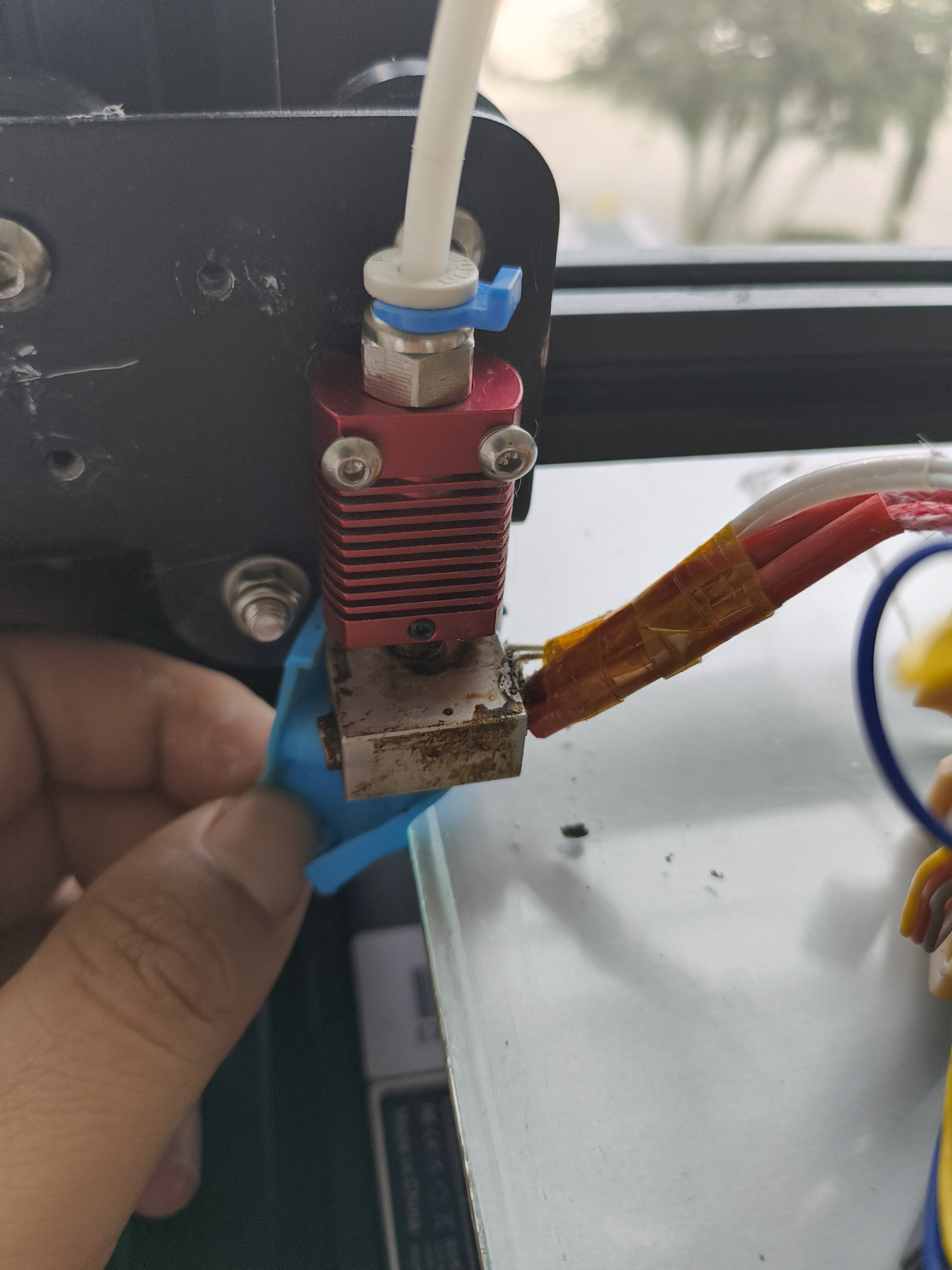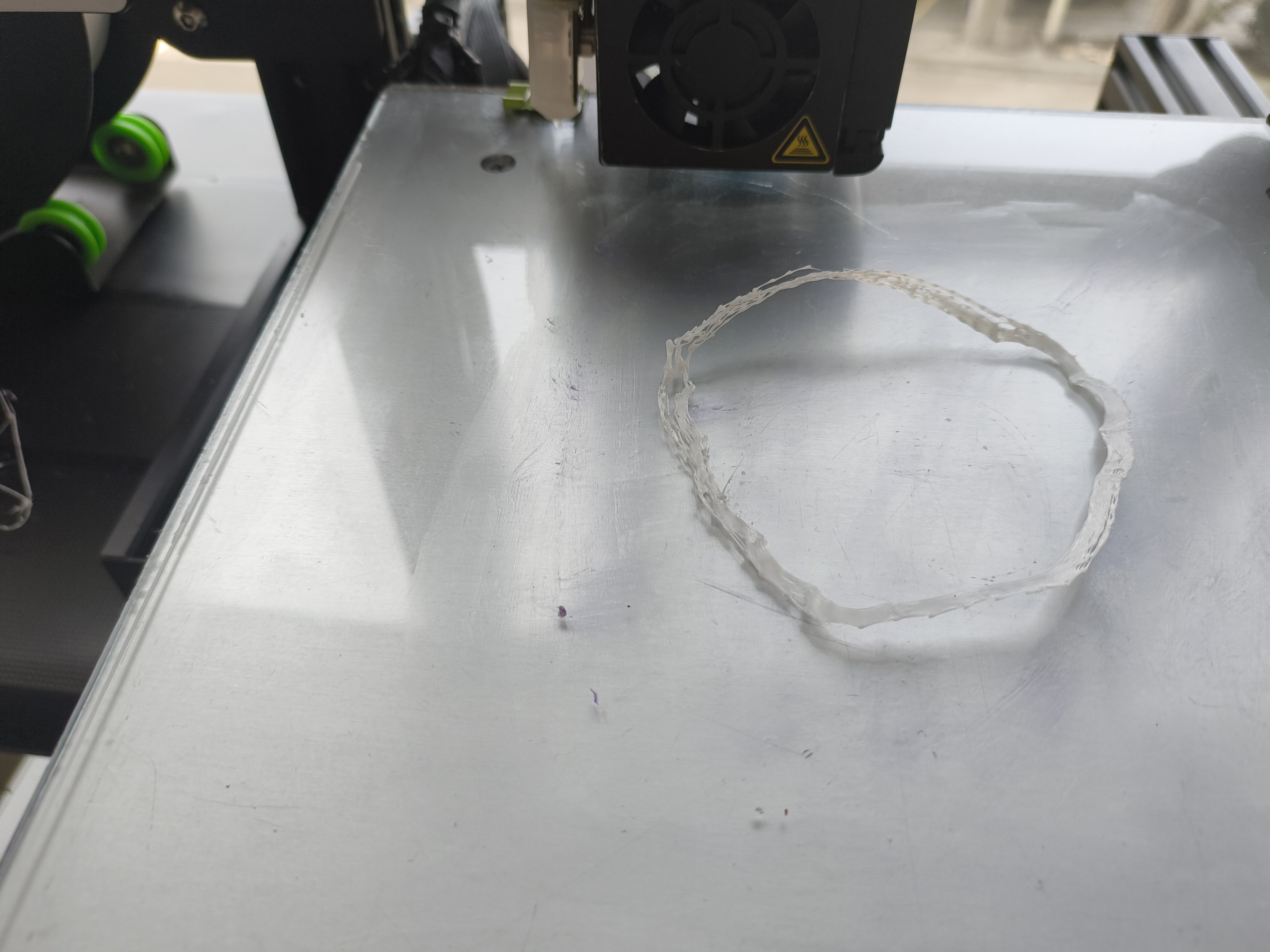Hi so my printer was fine until oneday a print finished with some under extrusion, when I check it seems to extruded in little beads (which combine into blobs as seen in the photo) during prints but not when told to extrude through octo print. Brand new filiment so humidity isn’t an issue, I’ve tried leveling the bed (glass with bltouch), using glue stick, cleaning the nozzle, I cleaned the hot end, sniped down the bowing tube and made sure it was flush with the nozzle. I’m at my whits end and am about to start praying to the omnisiere for divine intervention. Any help would be appreciated.
Make sure you didn’t accidentally turn “E in mm^3” on in the settings (if it’s stock firmware) – no fucking clue why they allowed that setting to stay on that machine; as it was from a time when switching from the 3mm standard to 1.75mm standard.
Also, never listen to anyone who tells you to start adjusting E-steps to fix a flow problem. They mean well, but they clearly don’t have enough experience to understand when or why you’d want to change that. E-Steps is a calculated value from the manufacturer based on known dimensions. If something is wrong hardware-wise, you fix THAT instead. E-Step adjustment was for the old days when you were making your own hobbed bolts by running a tap along the edge of a bolt and every bolt you made came out with a different effective diameter. Manufacturers know the exact diameter of their drive gears, and thus know the correct estep value and you don’t need to change it.
sniped down the bowing tube and made sure it was flush with the nozzle.
The fact that you said you snipped the bowden tube worries me; you’ve gotta cut it with a blade. Flush cutters do not leave it flat enough at the bottom and you’ve likely just caused yourself more issue. Either use a PTFE cutter designed for it, or a razor blade of some sort (Xacto knife, paint scraper blade, etc)
https://www.youtube.com/watch?v=uKN0VOuul0o – This video is quite possibly one of the best videos on the subject matter. Take 14 minutes out of your life and read it and commit the knowledge to memory; especially if you own an older Ender 3.
You can also disconnect your PTFE tubing from the extruder side of the equation, heat up your hot end, and try to extrude 100mm of filament, while trying to hold back the filament from the extruder – It should be pretty strong, if it slips too easily, you can narrow down your issue to the extruder. If it’s strong, but it’s tearing the filament apart when you try and print - then the issue will be down at the hot end. (Or possibly misconfigured slicer setting, like you’ve set your layer height to 3.0mm instead of 0.3mm for example) You want to divide and conquer here. Test the pieces separately, then fix the actual issue.
Additionally, Touch probes don’t fix leveling issues. If the machine isn’t printing fine before you add a touch probe, they won’t magically make things work - all they do is automate the process for an already perfectly-functioning machine. They can also correct for non-linear malformations, but they are not there to fix a leveling issue if you have one.
Check your nozzle diameter too – that looks similar enough to glow-in-the-dark filament that I’m going to mention it – DON’T. Glow in the dark filament is as abrasive as carbon fiber, and if your machine isn’t set up to handle it, it will wallow out a nozzle until it doesn’t match what the printer expects. If it’s wallowed out, you’ll regularly end up with nasty surfaces, etc.
There are so many things that this could be. Change your E-steps back to 93 if you’ve changed it. You’ll only mask the problem. If you’ve swapped over to some sort of dual-gear extruder (bad idea btw) - make sure your E-steps match what they tell you to use (typically 130) - or you can get this too.
More, good, well-lit pictures of the extruder area of your machine would help diagnosis - hot end with the fan shroud/cover off might help too. Basically – the more information you can give us, the easier it is for us to help. Pictures do a lot for those with good attention to detail; as you might miss something that we won’t.
So the extruder seems fine I releveled the bed for the 20th time and even opened the hot end and cleaned it just incase, same issues. The filiment is pla + not glow in the dark but maybe the nozzle is worn out I’ll order new ones from Amazon and check back in when I can



That extrusion seems awfully fat for a 0.4mm nozzle. But also probably shows that your extruder is pushing mostly fine.
If it’s a silk filament, however, they tend to die-swell much more than others.
Stop “leveling the bed”. If you’ve leveled it once, it’s probably good enough - the problem is most definitely in your extruder or somewhere else.
What extruder are you using (the thing that pushes the plastic?) You’ve shown your hot end, but not the business end of the thing that feeds the filament.
Stock ender 3 with metal body

Good stuff. It looks like you put the lock washer on the M4 nut that holds the idler bearing on the arm correctly. Soooo many people fuck that simple thing up.
The set screw doesn’t seem to be aligned with the flat on the motor shaft - I’d make sure that’s tightened up; but otherwise, everything looks fine…ish.
Only thing I see missing is something called a “Rivnut”; it looks kind of like a little thimble looking thing – it’s supposed to go inside of the spring, and cover the M4 buttonhead and act as a tensioner - but in most cases, you don’t need to be adjusting that anyways, so what you have here is fine. Good job assembling it correctly.
So to start with, you mentioned the underextrusion on a previous print. Seems like a good starting point, when was the last time you checked your E-steps? Basically you want to disconnect the bowden tube from the hotend, extrude out a short amount of filament and mark its position, then extrude 100mm of filament and measure how much actually came out. From there, there is a formula to adjust the E-steps on the printer. Ideally you should have exactly 100mm come out but there’s a good chance you’re going to have less than this. You can also make some adjustment to this from your slicer (in the material flow section) but that can cause various other problems, so ultimately you’ll want to get this value corrected in the printer itself.
While the bowden tube is disconnected, this is a good time to try doing a cold-pull. Heat the hotend up to around 200C again, stick some scrap filament into it so it just starts to push filament out the bottom, then let the hotend cool back down to near 160C (or maybe even cooler, but this is a good start). Pull the blob of filament out of the hotend, and you should have a bullet-shaped plug on the end of it. Look this over to see if there is any burnt filament, contaminants, or anything else that looks weird. If you see obvious contaminants then this is likely causing your underextrusion. After doing this, you should also check the nozzle itself, sometimes as they wear out a bit of the brass gets pushed over and blocks the flow. Always keep spare nozzles on hand, they wear out faster than anything else.
And one more thing before reassembling… Check the extruder itself. After some time it is common for the brass gear to get clogged up with filament or simply have the teeth wear down, especially from some of the fancy filaments like wood, glow-in-the-dark, or even the metallics. However the results of these problems should be fairly obvious from a clicking in the extruder while printing. Clean out any obvious filament remains, or you can get a pack of replacement gears pretty cheap.
When you are ready to reassemble the bowden tubing, check the fittings at both ends. These wear out easily, so you may see signs that the tubing have been shifting back and forth. These really need to prevent any movement in the bowden tubing, so if you’re going to order parts anyway, get a pack of these to hand on hand. Bad fittings can cause serious underextrusion any place the extruder reverses directions like at the end of a wall. but the wall itself should lay down fairly cleanly.
Hope that gives you some ideas to run with. Some of this will depend on the specific model of Ender you have, but if it was working fine and just suddenly started having problems then something blocking the filament flow is at the top of the list of possibilities.
If prints were fine before the incident I would probably leave e-steps alone.
Agree 100% with the steps you outlined. To add on:
- when OP tells the printer to extrude during octoprint, what does the extruder do? Is the motor grinding (not enough tension) or clicking (indicative of a clog)?
- any new noises when printing?
- when OP pulls the filament out of the hot end, is there evidence of the gears grinding on the filament?
May be a good time to see if there bits of filament in the extruder gears and if they’re ok. And, if they are, to clean the nozzle either by using filament or a cold pull.
Everything is fine when extruding with octo print, no noises or ripped filiment but when I hit print on any files even old ones it seems to start extruding in beads
If the extrusion looks normal with octoprint and weird when doing a real print, how far is your nozzle off the bed? If it’s too high you’ll get stringy looking prints due to not enough squish.
I suspect when you were using octoprint the nozzle wasn’t on the bed, but it was for the “real” print.
Should be close enough, using a sheet of paper when leveling. Watching the print I notice it doesn’t like to stick to the bed even when latered with glue stick.
Last time my printer did that, there was an alignment problem between the extruder and the end of the hot-end. It later also started to clog the hotend, when the alignment got worse.
The other time I had a similar problem, I’ve unknowingly lost my slicer settings and had the filament size misconfigured.
So looks like the nozzle needed replacing, the Amazon replacement nozzles came in and I’m doing a test print rn but do far so good. I’ll follow up when the print is done but it seems to have been the nozzle.
Do you know how to check for bowden gap, and how to hot tighten the hotend/nozzle in order to prevent it?
You may also want to check the extruder arm. The stock plastic one on the ender 3 is prone to cracking.
Already upgraded to metal I’m just praying rn lol


